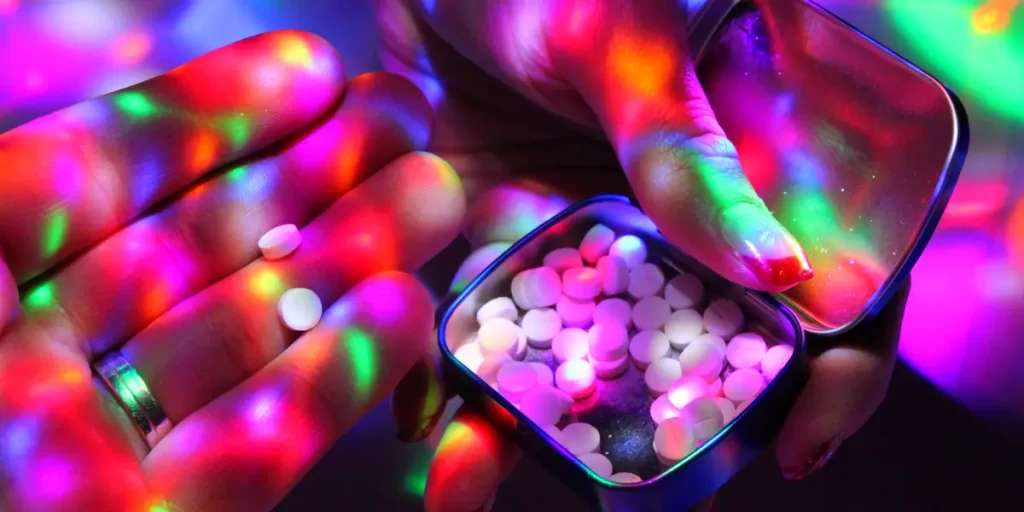Ecstasy Withdrawal and Detox Treatment
Written by Jonathan Strum
& Medically Reviewed by Dr. Bonnie Bullock, PHD
Medically Reviewed
Up to Date
Last Updated - 6/17/2022
View our editorial policy
Ecstasy is a drug that gained popularity in the 1970s and 1980s. Before ecstasy’s ban in 1985 by the Drug Enforcement Agency (DEA), the drug was given to patients by psychiatrists in an effort to foster better communication during sessions. After the ban, the drug became popular in underground dance, rave, and club scenes. Ecstasy’s main ingredient is known as MDMA (3,4-methylenedioxymethamphetamine). Drugs containing MDMA may be referred to as molly, ecstasy or e, x and many other “brand” names depending on the illegal manufacturer of the drug.
Ecstasy is unique in that it has both stimulant and hallucinogenic properties. As a result, ecstasy’s “high” causes increased energy, warmth, changes in perception and time, sensory changes (such as seeing vivid colors) and the desire to be close to other individuals. While there may be some practical utility in feeling more empathetic and close to others, ecstasy use carries risks.
The jury is still out about whether MDMA is truly addictive. Several studies have shown that many pathways in the brain associated with addiction are also activated when a person takes ecstasy. Additionally, some individuals report feeling ecstasy withdrawal after stopping use. It has also been reported that MDMA comedown leads to severely unpleasant sensations and feelings.
People who experience addictive behaviors and withdrawal symptoms due to ecstasy use should consider seeking treatment at a rehab facility. Many facilities across the country offer medically assisted ecstasy or MDMA detox.
Symptoms of Ecstasy/MDMA Withdrawal
Symptoms of MDMA withdrawal can vary in intensity depending on the amount of ecstasy consumed and how long a person uses the drug. Withdrawal effects of ecstasy also range from unpleasant to dangerous, especially if an individual has underlying health issues or struggles with additional mental health conditions. MDMA use can cause withdrawal symptoms because people feel euphoric after ingesting the drug and then later feel a “crash.” This is due to changes in neurotransmitter signaling involving dopamine, serotonin and norepinephrine.
A person may develop cravings to feel the initial euphoric feeling that comes from ecstasy use. People may also develop a dependence on the drug if they require it to feel normal or euphoric. Dependence occurs if neurotransmitter signaling becomes altered for a long period due to routine MDMA use.
How can a person recognize the different symptoms of ecstasy withdrawal? Some symptoms may include:
- Becoming more aggressive
- Feeling depressed or anxious
- Being more tired than usual
- Experiencing hallucinations
- Changes in heart functioning (irregular heartbeat)
- Becoming more irritable
- Experiencing panic attacks
- Problems paying attention
- Having suicidal thoughts
- Difficulty sleeping
- Not being able to control impulses
Ecstasy Withdrawal Timeline
The effects of ecstasy last about 3–6 hours, and the half-life is approximately 6–9 hours. Even after the initial effects of MDMA wear off, the drug remains in a person’s system for up to two days. The severity of withdrawal symptoms depends on how frequently and how much ecstasy a person consumes.
Withdrawal symptoms may occur as soon as the effects of the drug wear off, or they may start a few days later. In a vicious cycle, people who are severely addicted to MDMA crave the drug and may continue to use it to avoid experiencing withdrawal symptoms.
Most individuals will not experience withdrawal symptoms until at least two days after they stop taking the drug. About three days to a week after someone stops taking the drug, more severe withdrawal symptoms may kick in. After about one week, most withdrawal symptoms will start to improve and the person will feel more normal again.
Dangers of Ecstasy Withdrawal
There are some dangers associated with withdrawal. It is important to note that the longer an individual uses MDMA, the more severe their withdrawal will be. Another danger comes from the purity of the MDMA a person uses. Often, ecstasy is impure and is mixed with potentially dangerous drugs, such as synthetic cathinones (bath salts), cocaine and even Viagra. As a result, people may have to withdraw from MDMA while also withdrawing from multiple other drugs.
Ecstasy/MDMA Detox
For people who are addicted to or dependent on ecstasy, there are many different options for ecstasy detox. Detox refers to the detoxification process to get rid of ecstasy completely from a person’s body. People may opt to detox from MDMA at home, at a treatment center or through an inpatient or outpatient rehabilitation program. People may also opt for a medically assisted detox.
It is highly recommended that people detox at a facility rather than at home. If they choose to receive treatment for ecstasy, they will first be evaluated by a medical professional to discuss the terms of their detox. At this time, they will likely talk to physicians about medically assisted detox, tapering from ecstasy or quitting cold turkey. People may also speak with therapists about any co-occurring mental health conditions in addition to their drug addiction. Crafting a unique detox plan that includes coping strategies and future plans can help people stay on a healthy path.
Medical professionals can help make the detox process more comfortable for patients, especially those who have used ecstasy for a long period. Detox will take a few days for some people, but it may take upward of a week for others. Having a support system made up of medical professionals, family and friends are critical during this difficult time.
It’s important to understand that detoxification is often the first step in the recovery process. After detoxification, patients will learn effective coping strategies to prevent relapse and develop relapse prevention plans. Relapse prevention plans provide people with resources to use after they complete treatment at a facility, helping them transition back to their regular lives. Finding healthy and constructive distractions (such as playing sports or exercising) can help people shift their focus away from ecstasy and other drug use.
Medically Assisted Detox
Medically assisted detox is typically offered under the supervision of a medical professional at an inpatient or outpatient facility. The goal of a medically assisted detox is to ease withdrawal symptoms by giving the patient medication. Unfortunately, there are no medications that can specifically treat ecstasy withdrawal. However, there are some medications that can facilitate an easier withdrawal period from ecstasy and decrease the chances of relapsing.
Tapering Off Ecstasy
Some people may choose to quit ecstasy cold-turkey (stopping suddenly). Other people may find that tapering off ecstasy is an easier alternative, gradually reducing the amount taken. When individuals attempt to quit suddenly at home rather than at an accredited facility, withdrawal symptoms may be even more severe. There is a greater potential for relapse in this case.
Finding an Ecstasy Detox Center in Washington and Oregon
There are many different options for ecstasy withdrawal treatment in Washington and Oregon. First, people may want to call local helplines for resources about different treatment facilities in the Pacific Northwest. There are also many resources online for detox options in Portland, Oregon, and the state of Washington.
Do you or someone you know struggle with ecstasy use? If so, The Recovery Village Ridgefield can help. Contact us today to learn more about our medical detox center. Our representatives are happy to answer any questions you may have about addiction treatment and the detoxification process.
Sources
National Institute on Drug Abuse. “Is MDMA Addictive?” September 2017. Accessed October 5, 2019.
National Institute on Drug Abuse. “What is MDMA?” June 2018. Accessed October 5, 2019.
National Institute on Drug Abuse. “What is the history of MDMA?” September 2017. Accessed October 5, 2019.
Toxnet. “3,4-Methylenedioxymethamphetamine.” December 12, 2018. Accessed October 5, 2019.
View Sources
National Institute on Drug Abuse. “Is MDMA Addictive?” September 2017. Accessed October 5, 2019.
National Institute on Drug Abuse. “What is MDMA?” June 2018. Accessed October 5, 2019.
National Institute on Drug Abuse. “What is the history of MDMA?” September 2017. Accessed October 5, 2019.
Toxnet. “3,4-Methylenedioxymethamphetamine.” December 12, 2018. Accessed October 5, 2019.
Authorship






